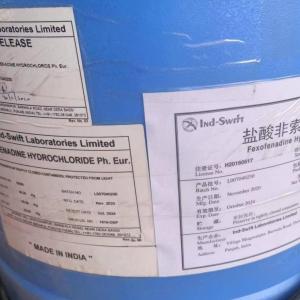
|





| 货号 | LB278 |
| 品牌 | LIBEN |
| 用途 | 科研 |
| 外观 | 白色结晶粉末 |
| 包装规格 | 25KG/桶 |
| 纯度 | 99% |
| CAS编号 | |
| 别名 | 索那定盐酸盐 |
| 保质期 | 36月 |
| 级别 | 医药级 |
| 质量标准 | USP40 |
Flow rate :0.5 mL/min.
Detection :spectrophotometer at 220 nm.
Injection:20 μL.
Run time :1.2 times the retention time of fexofenadine.
Relative retention with reference to fexofenadine (retention
time = about 20 min) : impurity B = about 0.7.
System suitability:reference solution (a) :
– resolution :minimum 3.0 between the peaks due to
fexofenadine and impurity B.
Limits :
– correction factor:for the calculation of content, multiply
the peak area of impurity B by 1.3 ;
– impurity B :not more than the area of the principal peak
in the chromatogram obtained with reference solution (b)
(0.1 per cent).
Related substances.Liquid chromatography (2.2.29).
Buffer solution.Dissolve 6.64 g of sodium dihydrogen
phosphate monohydrate R and 0.84 g of sodium perchlorate R
in water for chromatography R,adjust to pH 2.0 ± 0.1 with
phosphoric acid R and dilute to 1000 mL with water for
chromatography R.
Solvent mixture.Mix equal volumes of acetonitrile for
chromatography R and the buffer solution.
Test solution (a).Dissolve 25.0 mg of the substance to be
examined in 25.0 mL of the solvent mixture.
Test solution (b).Dilute 3.0 mL of test solution (a) to 50.0 mL
with the mobile phase.
Reference solution (a).Dissolve 25.0 mg offexofenadine
hydrochloride CRS in the solvent mixture and dilute to 25.0 mL
with the solvent mixture. Dilute 3.0 mL of this solution to
50.0 mL with the mobile phase.
Reference solution (b).Dilute 1.0 mL of test solution (a) to
100.0 mL with the mobile phase. Dilute 1.0 mL of this solution
to 10.0 mL with the mobile phase.
Reference solution (c).Dissolve 1 mg each offexofenadine
impurity A CRS and fexofenadine impurity C CRS in 20 mL of
reference solution (a) and dilute to 200.0 mL with the mobile
phase.
Column:
– size : l = 0.25 m, ? = 4.6 mm ;
– stationary phase: phenylsilyl silica gel for chromatography R
(5 μm).
Mobile phase:mix 350 volumes of acetonitrile for
chromatography R and 650 volumes of the buffer solution ; add
3 volumes of triethylamine R and mix.
Flow rate:1.5 mL/min.
Detection :spectrophotometer at 220 nm.
Injection:20 μL of test solution (a) and reference solutions (b)
and (c).
Relative retention with reference to fexofenadine
(retention time = about 9 min) : impurity A = about 1.7;
impurity D = about 2.3; impurity C = about 3.2.
Run time :6 times the retention time of fexofenadine for test
solution (a) and reference solution (c), twice the retention
time of fexofenadine for reference solution (b).
System suitability:reference solution (c) :
– resolution :minimum 10 between the peaks due to
fexofenadine and impurity A.
Limits :
– correction factor:for the calculation of content, multiply
the peak area of impurity A by 1.4 ;
– impurities A, C, D :not more than the area of the principal
peak in the chromatogram obtained with reference
solution (b) (0.1 per cent);
– unspecified impurities :for each impurity, not more than the
area of the principal peak in the chromatogram obtained
with reference solution (b) (0.10 per cent) ;
total:not more than 3 times the area of the principal peak
in the chromatogram obtained with reference solution (b)
(0.3 per cent) ;
– disregard limit:0.5 times the area of the principal peak in
the chromatogram obtained with reference solution (b)
(0.05 per cent).
Water (2.5.32): maximum 0.5 per cent.
Dissolve 1.000 g in anhydrous methanol R and dilute to 5.0 mL
with the same solvent. Use 1.0 mL of this solution.
Sulfated ash (2.4.14): maximum 0.1 per cent, determined on
1.0 g.
ASSAY
Liquid chromatography (2.2.29)as described in the test for
related substances with the following modi?cations.
Injection:test solution (b) and reference solution (a).
Run time :twice the retention time of fexofenadine.
Calculate the percentage content of fexofenadine
hydrochloride from the declared content offexofenadine
hydrochloride CRS.
IMPURITIES
Specified impurities : A, B, C, D.
Other detectable impurities (the following substances would,
if present at a suf?cient level, be detected by one or other of
the tests in the monograph. They are limited by the general
acceptance criterion for other/unspeci?ed impurities and/or
by the general monograph Substances for pharmaceutical use
(2034).It is therefore not necessary to identify these impurities
for demonstration of compliance. See also 5.10. Control of
impurities in substances for pharmaceutical use):E, F, G.